With the introduction of the USB-C connector in iPhone 15 and beyond, including iPhone 15 Pro, Apple has simplified the connectivity and charging experience. But what does it mean for you? In this comprehensive guide, we’ll delve into all you need to know about the USB-C port on your iPhone 15, from the basics of charging to the advanced connectivity features that can revolutionize the way you use your device.
The universal adapter feature of USB-C in the latest iPhones creates a world of opportunities that many users have not fully taken advantage of yet. Whether you’re seeking faster charging, effortless file transfers, external display connections, or an improved audio experience, the USB-C port stands as your gateway to unlocking advanced capabilities.
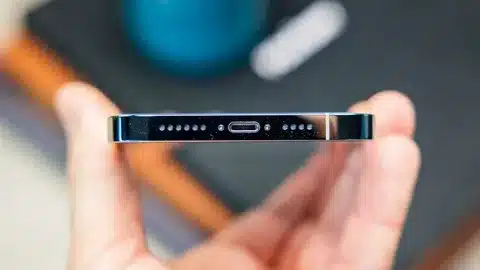
In this blog post, we will explore the different uses of the USB-C connector, offering helpful tips and insights to help you make the most of your iPhone experience and get the most from Apple’s newest connectivity standard.
Understanding USB-C in iPhone 15 and Later Models
What is USB-C?
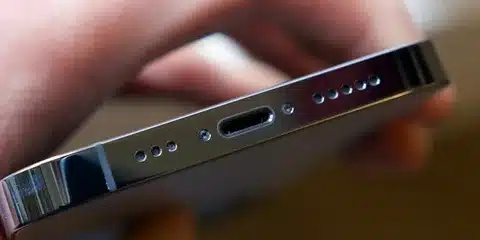
Universal Serial Bus – USB-C is the newest generation of universal connectivity protocols, replacing the previous Lightning port. The reversible connector has big benefits over previous Lightning and older USB connectors, including faster data transfer speeds, increased power delivery capabilities, and cross-device, cross-manufacturer compatibility.
USB-C can work with multiple protocols at once, which means that it can be used for charging, transferring data, sending video output, and transmitting audio all at the same time. It is therefore a versatile option for the advanced smartphones where the space is limited and the users are demanding the most functionality.
Why Apple Made the Switch
Apple’s adoption of USB-C was not just a trendy change in the industry, especially for the pro models; it was a reaction to regulatory requirements and user demands for interoperability. The European Union’s requirement for common charging standards was a critical part of that, but the advantages go much farther than being compliant.
The switch allows iPhone users to share the same cables and adapters with their entire ecosystem of devices, such as MacBooks, iPads, and a wide range of accessories. This standardization saves e-waste and makes the user experience very much simpler.
Device Compatibility
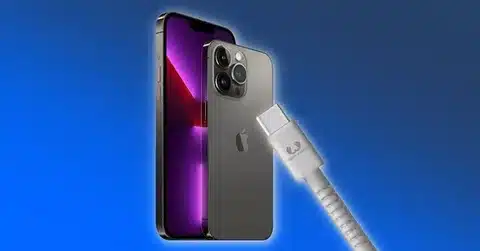
Cable Compatibility: iPhone 15 USB-C port is compatible with a wide variety of devices, including those that support wireless charging. You can pair Mac computers, iPads (USB-C), AirPods Pro 2 (USB-C charging case), third-party accessories and peripherals (thousands of them).
This compatibility includes charging accessories, external storage, audio devices, displays, and even some Android devices to share files. The universal nature of USB-C means chargers and cables are often interchangeable across device brands, so you can often borrow them from friends when you’re out and about.
Charging Your iPhone via USB-C: Standard and Fast Options
Standard Charging Methods
The iPhone 15 comes with a charging cable, a USB-C to USB-C cable in the box, which is to be used with a USB-C power adapter. Any USB-C power adapter with a minimum wattage of 5W will work for standard charging; however, charging speeds will be affected by the power output of the adapter.
Using a standard 5W adapter, charging your iPhone 15 from empty will take anywhere from 2-3 hours for a full charge, but with USB Power Delivery, you can achieve faster results. While this is fine for overnight charging, faster options are available for day users who want to power up faster.
The beauty of USB-C charging is how smart it is: Your iPhone will not take more than necessary, so plugging it into a higher-wattage adapter will never harm your device. This safety feature means that you can use laptop chargers or other high-powered USB-C adapters without worrying.
Fast Charging Capabilities: This applies to all usb c iPhones, including the iPhone 15.
To charge as fast as possible, Apple recommends a USB-C power adapter of 20W or more. Charge Your iPhone 15 in 30 Minutes: With this configuration, your iPhone 15 is capable of charging to approximately 50% within a span of 30 minutes, allowing you to quickly transfer video files as well.
Fast charging is especially important for heavy users who need their phones all day long, and the iPhone 15 supports fast charging capabilities. The technology automatically changes charge speeds according to battery temperature and charge level, reducing speeds as the battery nears 100% to maintain the long-term health of the battery.
What a lot of users don’t know is that fast charging is better for lowering the battery below 50%. As your iPhone charges to higher levels, the charging speed automatically reduces to ensure the longevity of the battery and optimal performance.
Reverse Charging Features
One of the more exciting features of USB-C on Pro and iPhone 15 is the ability to charge other devices. Your iPhone can now serve as a power bank for compatible accessories such as AirPods, Apple Watch (with the use of compatible adapters), and even other mobile phones in case of an emergency.
This ability to charge in reverse is especially helpful when you are traveling or in situations where you don’t have access to traditional charging methods, particularly wired charging. While it will suck the battery out of your iPhone, it can be a lifesaver for keeping important accessories charged.
The technology is automatic when connecting compatible devices – your iPhone will know when another device needs power and will start sharing its battery charge when required.
Connecting to Other Devices: Data Transfer and Storage
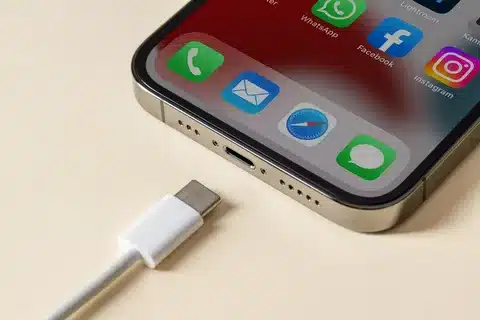
High-Speed Data Transfer
The USB-C port on iPhone 15 supports USB 2.0 speeds for data transfer, so you can transfer photos, videos, and documents between your iPhone and computers much faster than with previous wireless transfer methods. Transfer speeds up to 480 Mbps in ideal conditions
This feature comes in handy especially for photographers and videographers who need to transfer large files from their iPhone to editing stations without any delay. The direct connection also means more reliable transfers than cloud-based solutions, which rely on internet connectivity.
Professional users will find the combination of high data capacity with the ability to back up data directly to external drives without iCloud or other cloud services useful to maintain greater control over data and privacy.
External Storage Solutions
As with the iPhone 15, you have the ability to connect external storage media to your device, including USB-C flash drives, external SSDs, and select external hard drives. This capability opens up new possibilities for using your iPhone for work, travel, and content creation.
External storage is especially handy if you need to increase the capacity of your iPhone without spending the money to purchase more storage. You can store movies for a long flight, backup photos and videos, or even execute some apps that can support external storage.
When you plug in external storage, your iPhone will automatically launch the Files app, where you can view, organize, and manage files just like you can with a computer. Through this seamless integration, you can work with your files in ways you never thought possible.
CarPlay Integration
USB-C connectivity: USB-C connectivity enhances the CarPlay experience by delivering faster data transfer speeds and more stable connections to compatible vehicles. Improved Stability: With enhanced connectivity stability, there are fewer interruptions during navigation or music streaming.
Many newer cars are equipped with USB-C ports that are specifically designed for smartphone connectivity, so that you don’t have to worry about using adapters or the older USB-A to Lightning cables. This direct connection typically gives you faster charging while driving.
This faster data connection also translates to better audio streaming and faster navigation updates, resulting in a smoother and more pleasant driving experience.
Audio Playbook Through USB-C: Wired and Wireless Options
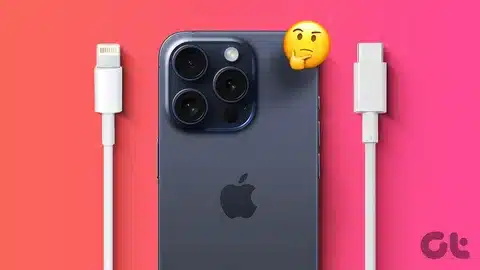
High-quality audio output: The iPhone 15’s USB-C port allows for high-quality audio output via wired connections. We are also providing both USB-C headphones and the standard 3.5mm headphones via Apple’s USB-C to 3.5mm Headphone Jack Adapter.
Wired audio over USB-C allows for superior sound quality compared to wireless options and eliminates concerns about compression or running out of power. Audiophiles especially appreciate the fact that high impedance headphones can be used with suitable adapters or DACs (Digital-To-Analog converter).
Low Latency: The low latency of wired connections makes USB-C an excellent choice for professional audio applications, especially for musicians, podcasters, and content creators who require precise audio monitoring without delay.
Adapter Compatibility
USB-C to 3.5mm Headphone Jack Adapter offers easy compatibility with your current headphones and audio equipment. This tiny adapter preserves high audio quality while letting you use just about any wired headphone or audio device.
There are several manufacturers of USB Type-C audio adapters, providing different functionalities such as inline volume controls, microphone support, and better DAC chips for better sound quality. These options give the user flexibility to determine which option best fits their needs.
Even higher-end adapters may have additional features, such as hardware volume controls, multiple output options, or built-in amplification for use with more demanding headphones, offering even more audio options.
Wireless Audio Alternatives
While USB-C does support great wired audio connectivity, wireless alternatives such as AirPods still reign supreme for their convenience and seamless integration with the iPhone ecosystem. The decision between wired and wireless is often a personal preference and use case-specific.
Advanced Audio Processing: AirPods Pro and AirPods Max features such as active noise cancellation and spatial audio complement iPhone 15’s advanced audio processing capabilities, providing an immersive listening experience.
Third-party wireless headphones: iPhone 15 also supports third-party wireless headphones, providing users with a vast ecosystem of Bluetooth audio devices with different features and prices.
Connecting to Displays and Monitors: Expand Your Screen
External Display Support: USB-C connectivity also opens avenues to countless usb c accessories.
USB-C Video Output: The iPhone 15’s USB-C port can be used to output video to external displays, allowing you to mirror your iPhone screen or extend it for improved productivity. This feature turns your iPhone into a mobile workstation that can be used to power up larger screens.
Up to 4K at 60Hz supported resolutions – giving you clear, crisp images that are perfect for presentations, video editing, or entertainment. The high refresh rate of the iPhone provides smooth motion and responsive interactions when you use your iPhone with external displays.
This feature can be extremely useful for business users who need to present content from their iPhone, content creators who want to preview their work on a bigger screen, or anyone who wants to enjoy their iPhone’s content on a bigger display.
Required Adapters and Accessories
If you need to connect your iPhone 15 to displays that don’t have USB-C inputs, here are the adapters that you will need: Apple USB-C Digital AV Multiport Adapter: This adapter is popular because it offers HDMI output and secondary USB-A and USB-C ports for charging.
Different adapters are needed for different types of displays–HDMI for most modern displays, DisplayPort for many monitors, and VGA for older displays. Third-party manufacturer adapters: Several multi-port adapters are made by third-party manufacturers that can support multiple display types at the same time.
You should keep your needs in mind while choosing adapters: some of them have a pass-through charging feature to keep your iPhone’s battery charged throughout long usage hours, and others aim to be simple and portable.
Troubleshooting Common USB-C Issues
Connection Problems and Solutions
If you are having trouble connecting to your iPhone 15 using the USB-C port, the first thing you should try is checking the cable and port for any debris or damage. Dust, lint, or moisture will prevent proper connections, so it should be removed carefully with the proper tools, lightning connector.
You should try different cables or adapters to determine the issue (iPhone, cable, or connected device). Investing in certified accessories is well worth the expense when it comes to guaranteeing increased reliability and performance of the cable.
Connection problems can sometimes be caused by problems with software. Restarting your device, resetting network settings, or updating to the latest iOS version can help you get rid of those stubborn connectivity problems apple switched.
Charging Troubleshooting Tips
Typically, an inadequate power adapter, damaged cable, or software glitch causes slower charging or failure to charge. Make sure you have a quality USB-C power adapter with enough wattage to meet your charging requirements iPhone 15 Pro Max.
Temperature can impact charging time – extreme hot or cold temperatures can cause your iPhone to charge slowly or not charge at all for a while to protect the battery. Ensure that your device is at normal operating temperatures before you charge it for gaming consoles.
If your iPhone still does not charge while the charger is connected, try cleaning the USB Type-C port and ensure that the cable is inserted correctly. Third-party cables: Third-party cables may not meet the same level of compatibility as Apple’s certified cables ipad pro.
Maximizing Your iPhone 15 USB-C Experience
USB-C connector on the iPhone 15 and other USB-C devices is a revolutionary move in the sphere of smartphone connectivity, as it is incredibly versatile and compatible with everything. Be it in rapid charging, data transfer, additional display features, and better audio features, USB-C opens up new opportunities in the way you can engage with your iPhone.
It is with these various functionalities that you can get the most out of what is possible by understanding and exploiting them, and even with the existing lightning accessories. The Universal: USB-C is universal, thereby making the same quality cables and adapters you spent your money on applicable across platforms and devices.
Therefore, do not waste time and learn about these features and see how USB-C can simplify your digital workflow and broaden the features of your iPhone. Be it a professional user who prefers longer working hours, or just a regular user who wishes to explore the hassle-free connectivity options, the USB-C port on iPhone 15 will bring on board some kind of value in one way or another because Apple has added many features that will improve the user experience.
We will venture into the USB-C adventures of iPhone 15 and discuss with you the insights of using the new connectivity standard by Apple on Android devices, as well as other enthusiasts.




